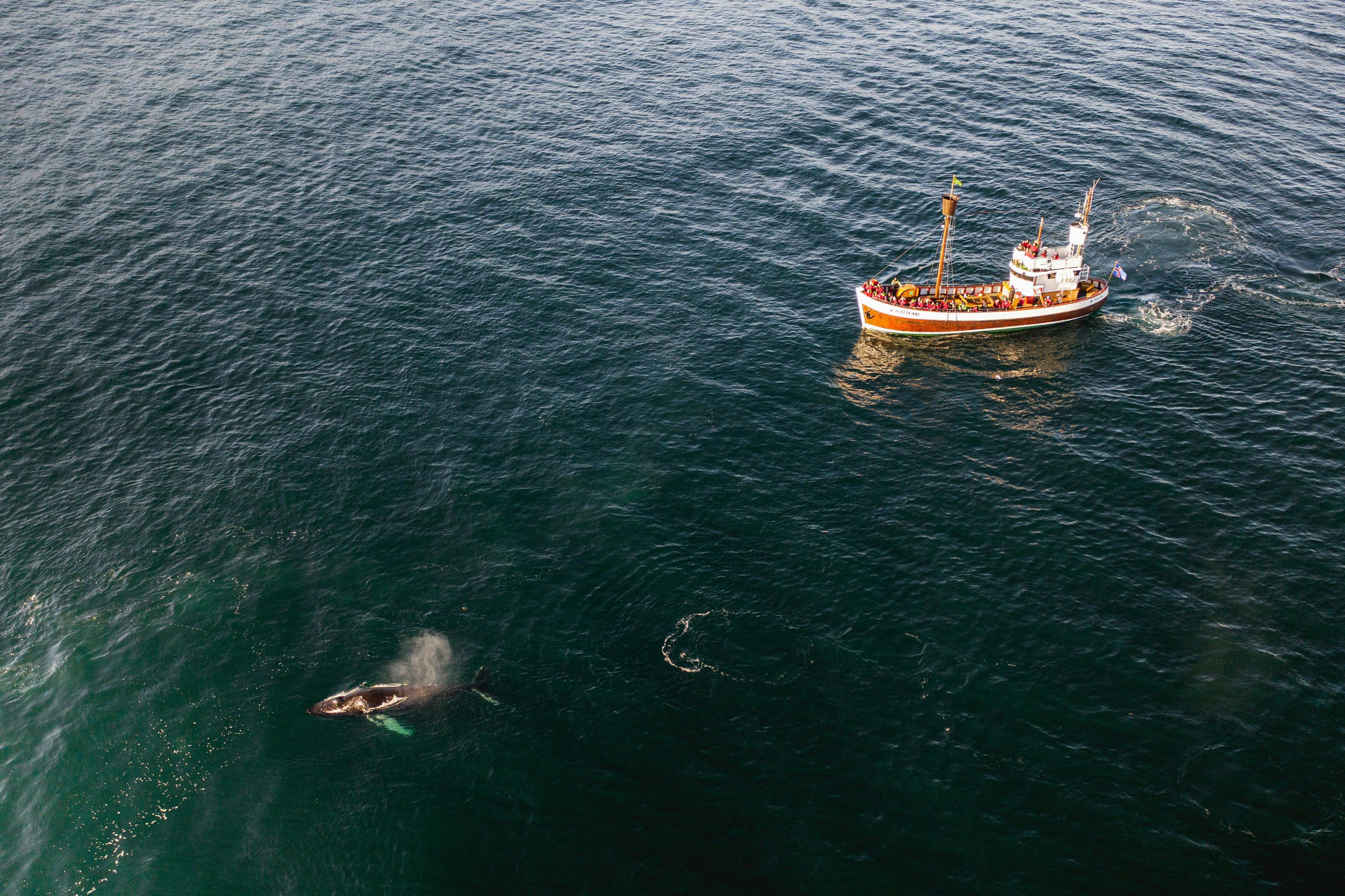
Humpback whales are commonly seen in Iceland.
There are a few things that Icelanders do not think about too much, but travelers to Iceland cannot get enough! These include northern lights, waterfalls, and whales!
Like the travelers who flock to see them, whales tend to visit Icelandic waters from May through September.
These are the months when the waters teem with the prey that various whales eat. Over 23 species of whales are found in Icelandic waters—a significant amount considering there are 80 to 90 species found worldwide. Some travel thousands of kilometers to gorge themselves in the rich waters where the Gulf Stream current meets the cold waters of the North Atlantic.

Whales are divided into two groups: toothed and baleen (filter-feeding) whales. Toothed whales, such as dolphins and killer whales, represent 90% of species, while the larger baleen whales, including the whale-watching superstar the humpback and the giant blue whale, represent 10%. Some people find it hard to imagine, but all whales are mammals, have live births, and provide milk for their young. Depending on the species, whales gestate from 10 to 18 months. Some are even born with hair that they quickly lose—an evolutionary holdover from their mammalian move from land to water!
The whales in Icelandic waters run from one of the smallest, the harbor porpoise, to the largest animal ever to evolve, the blue whale. Minke and humpback whales are sighted most commonly on whale watch tours and tend to feed closer to shorelines and in fjords. Many species are rare to see and are typically spotted far offshore, such as the sperm whale, the deep-diving Cuvier's beaked whale, and the North Atlantic right whale, of which there are sadly fewer than 400 left.
While the whales seen in Icelandic waters are generally passing through, there is much that we can still learn from them. Icelandic researchers monitor their diet, the impact of environmental changes in warming currents and plastics in the water column, and even tag them with GPS to follow their migration patterns. Here are some unbelievable facts about a few of the whales found in Iceland:
- The killer whale or orca is the largest member of the dolphin family. Keiko, the star of the 1993 film Free Willy, was captured in Iceland in 1979. Highly social animals, orcas speak different languages and live in extended family groups with life-long bonds. Interestingly, killer whales from Iceland cannot communicate with killer whales from Norway. They often travel and hunt together in organized groups called pods that are composed of various family members. Killer whales are found throughout the world's oceans and have varied diets according to their regions. Some like to eat fish, squid, penguins, seals, sea lions, and even other whales. They are apex predators. Killer whales in Iceland tend to eat herring.
- Occasionally seen in Iceland, the narwhal is considered the unicorn of the arctic seas. The long "horn" is two left teeth intertwined and growing out through the gum. Mostly the males have these teeth, but females occasionally grow them as well. In addition, 1 in 200 also has two teeth on the right side. These specialized teeth are used as a sensory instrument to mark the water temperature, salinity, breaking through thin ice and sparring with one another.
- The Cuvier's beaked whale is a marvel of evolutionary engineering. These rarely-seen whales dive to depths up to 3,000 meters (almost 10,000 ft). Military submarines (that we know about!) would collapse at around 730 meters (2,400 ft). They can stay underwater for 3.5 hours while seeking squid in pitch-black depths!
- Typically seen in the deep waters off the coast of Snæfellsnes Peninsula, the sperm whale—also known as the Moby Dick whale—is full of superlatives. These are the largest toothed whales at 20 m (60 ft) long, the loudest animals on earth, and the largest brains in the animal kingdom. Sperm whales are very social and live in extended groups, mostly of females working cooperatively. Their vocalizations can be heard from several hundred miles away—perhaps across oceans! There are louder than the Space Shuttle taking off 75 meters (250 feet) away at their maximum volume. If you were swimming with one, it could blow out your eardrums and vibrate a human body to pieces. Not to worry, there is no record of this happening. Sperm whales "see" and interpret the world through their echolocations.
- It is hard to believe the size and scale of a blue whale. Blue whale tongues alone can weigh as much as an elephant! After gestating for a year, blue whale calves weigh 3 tons and are up to 7 meters (25 ft) long. They only drink their mother's Greek yogurt-thick milk for a year, gaining about 90 kg (200 lbs) daily! Mothers consume four tons of food daily, filtering krill through their baleens—a crustacean that is about the size of your pinky finger!
Entire books have been written about these remarkable animals. What is clear is that the more we learn about each of these species, we realize how little we do know. When viewed from the deck of a tour boat, whales amaze and charm us. However, the more we research and study them, we realize that they thrive and perceive the world differently. It is up to us to minimize our impact on them and their environment as much as possible.
.jpeg?ixlib=gatsbyFP&auto=compress%2Cformat&fit=max&rect=0%2C0%2C2075%2C2075&w=90&h=90)